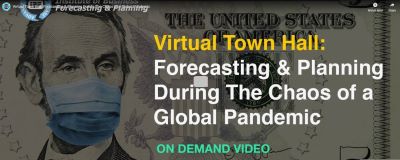Forecasting During Chaos
 The Institute of Business Forecasting has produced an 80-minute virtual town hall on "Forecasting & Planning During the Chaos of a Global Pandemic." The on-demand video recording is available now and well worth a look. There is much solid practical guidance from an experienced panel:
The Institute of Business Forecasting has produced an 80-minute virtual town hall on "Forecasting & Planning During the Chaos of a Global Pandemic." The on-demand video recording is available now and well worth a look. There is much solid practical guidance from an experienced panel:
- Eric Wilson, IBF DIrector of Thought Leadership (moderator)
- Dustin Deal, Director of North American Business Operations, Lenovo
- Patrick Bower, Sr. Director of Global Supply Chain Planning & Customer Service, Combe Inc.
- Andrew Schneider, Global Demand Manager for Supply Chain, Medtronic
- John Hellriegel, Sr. Advisor and Facilitator, IBF
Following are my key takeaways from each panelist:
John Hellriegel:
- Macro forecasting is hard enough right now, and micro forecasting (down to product level) even more so.
- There are many interventions going on beyond what is normal, such as government stimulus, fallen oil prices, etc. all adding to the uncertainty and complexity.
- High forecast accuracy in unlikely, so a demand planner should focus on helping the business understand the uncertainties and make appropriate decisions.
- Simple models with clear assumptions may be most helpful (for example, "Take a 25% reduction across a category for three months," rather than spend a lot of effort trying to adjust each item).
Dustin Deal:
- Production is ramping back up in China, yet there are still logistical delays.
- Be collecting data at macro and micro level, including channel inventory and sell through.
- Know where channel inventory is low, and where you'll need immediate replenishment.
- Execute planning (e.g. S&OP) more frequently.
Andrew Schneider:
- Not doing typical demand planning right now, instead focus on "demand sanitary services" (cleaning data, figuring how much is pre-buy to stock vs. actual consumption, etc.).
- Focus on demand control and shaping until things get back to normal.
- Utilize the coefficient of variation to identify which products are most impacted by Covid-19 (big increases in CoV). Segment the products according the impact. Consider a risk-based ABC analysis.
- Distinguish the "passive" work of observing and collecting data, versus the "proactive" work of driving demand from shortages to substitute available products.
- Assess the quality of the demand signal. POS is great if you have it, but if not, try to figure out what the customer really wanted (compared to what orders, cuts, backorders, etc. look like).
- Try to use additional streams of external data -- what does it say? -- not just your own internal data.
- Consider the probability distributions of demand, but don't commit yourself to the extreme and get your organization in trouble later when things normalize.
- Don't worry so much about accuracy right now. Instead consider the forecasting value add of different approaches
- Be the calm voice -- be realistic and understand the data before overreacting.
Patrick Bower:
- There is lots of complexity and ambiguity right now, not much demand planning can happen.
- We'll know more when March closes, and for now can just watch week-to-week but can't fully replan until we know more.
- There's no brand loyalty right now for scarce product, so brands will have a hard time knowing what is true demand.
- Document everything and reconsider the assumptions of existing plans. Get close to the data (especially cuts, backorders, and future returns) and know your customers. Be wary of future cancels.
- Suppliers may be unable to deliver in short term, so be aware of lead times.
- A big challenge is how to interpret data, handle outliers, adjust history, and adjust models. Better to do these in a couple of months when we have a better understanding. Collect the data but don't rush to make changes.
- Use S&OP to plan for the new normal (which will likely include recession).
- Take a breath and don't overreact. Reach out to experienced colleagues who have been through situations like this before.
Additional Suggestions from Charlie Chase
For some additional thoughts from my colleague Charlie Chase, see his new article, 6 Steps to Predicting Shifting Demand Patterns While Navigating the Coronavirus Crisis, published on RIS News. His steps:
- Use downstream data that reflects true consumer demand.
- Adopt and implement advanced analytics and machine learning algorithms in your demand forecasting and planning.
- Implement a short-term demand forecasting and planning process.
- Incorporate social media information.
- Focus on the granular view and regional geographic areas.
- How do you handle the abnormal historical data after everything goes back to normal?
SAS Coronavirus Dashboard
For more insight that may be helpful in your forecasting and planning efforts, some of my colleagues at SAS have created a Novel Coronavirus Report using SAS Visual Analytics that depicts the status, locations, spread and trend analysis of the coronavirus.
Data is updated nightly. The ability to visualize the COVID-19 outbreak can help raise awareness, understand its impact and can ultimately assist in prevention efforts. View the SAS Coronavirus dashboard to see maps based in ESRI, coronavirus statistics, and an animated timeline of worldwide spread.
